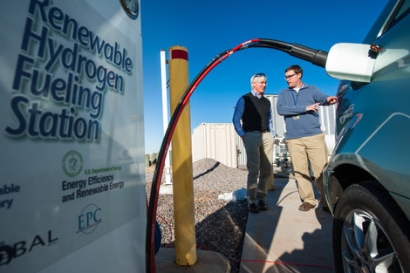
The Innovating to Net Zero report modelled 100s of potential pathways to 2050 – ramping up or down different technologies and behaviour changes – to understand the combinations, interactions and trade-offs of competing decarbonisation approaches.
The internationally peer-reviewed Energy System Modelling Environment (ESME) is the UK’s leading techno-economic whole system model – which as been used by the Committee on Climate Change (CCC), industry, academia and the UK Government. ESME is independent of sector interests and identifies cost-optimised decarbonisation pathways across the whole system.
“Last year the UK became the first major economy in the world to commit to a ‘Net Zero’ emissions target by 2050” said Energy Systems Catapult Insight and Evidence lead author Scott Milne. “Now for the first time, we’ve modelled hundreds of potential pathways to get to Net Zero by 2050, ramping up or down different technologies and behaviour changes – to understand the different combinations, interactions and trade-offs of competing decarbonisation options to reach the most cost-optimised approaches. Broadly each potential pathway uses a combination of two different approaches: a top-down technology focused approach or a bottom-up behaviour focused approach. However, what stands out is – no matter which pathway the UK takes – innovation, investment and incentives across low carbon technology, land use and lifestyle is essential to achieve Net Zero. And there are massive economic opportunities for the UK to lead the world in these areas.”
Whichever pathway the UK takes to Net Zero, it will need to include deploying more or less combinations of:
Low Carbon Technology
Carbon Capture & Storage with Bioenergy – may need up to 170 MtCO2/yr of storage by 2050 to capture industrial emissions (including hydrogen production) and to offset lifestyle emissions from air travel and livestock.
Hydrogen may need to grow to levels equivalent to today’s electricity generation up to 300TWh/annum to supply industry, heat and heavy transport.
Electricity generation will need to double to around 600TWh of supply for huge increases in heating and transport (perhaps treble if hydrogen uses electrolysis).
Offshore/onshore wind – in a high renewables case (where nuclear is not maximised) we will need 90GW of capacity, generating 370TWh. But still need 50GW generating 212TWh in a lower renewables case.
Solar – may need up to 80GW of capacity for 73TWh.
Advanced nuclear technologies – may need up to 30GW generating 230TWh in a high nuclear case.
Small modular nuclear – may need up to 7GW or around 20 reactors at 300MW each – are an option to support ¾ of all District Heat in cities.
Storage and Flexibility – we need major innovation and deployment in electric and heat storage technologies with timescales from seconds to seasons to manage extreme weather conditions.
Even if we successfully deploy these technologies, depending on the scale achieved, the UK will still need to adopt significant land use and lifestyle changes to reach Net Zero.
Land Use
Livestock production for dairy and meat – may need to be cut by up to 50 percent rather than 20 percent depending on the success of low carbon deployment.
Planting a forest up to twice the size of Birmingham every year (or a third the size of Greater London) – up to 50,000 hectares every year may need to be planted for carbon sequestration and offsetting up to 33 MtCO2/yr by 2050.
Biomass crops regularly harvested for energy (coupled with CCS) – offers more intensive and indefinite sequestration. Rising to ~120TWh/yr by 2050.
Lifestyle
Reduced meat/ dairy consumption – reducing by 20 percent will deliver 8 MtCO2e saving by 2050 versus today, however this may need to be reduced by 50 percent (19 MtCO2e saved) depending on the success of low carbon deployment.
Slower aviation demand growth – most assumptions suggest an increase in passenger demand of 60 percent versus 2005 levels, although as low as 20 percent growth may be needed depending on the success of low carbon deployment.
The report also found that Net Zero before 2050 is unlikely without highly speculative changes to lifestyle, land use and low carbon technologies – such as banning aviation and meat production.
Policy and Regulatory reform – 4 key policy recommendations
Innovation support for technologies – Nuclear, CCS and hydrogen – direct support for innovation and early deployment such as industrial clusters for CCS, funding mechanisms for CO2 transport & storage infrastructure, and support for advanced and modular nuclear and floating offshore wind.
Economic incentives to go low carbon – balanced, economywide framework of market, pricing and regulatory interventions – such as new carbon standards for buildings to promote adoption of low or zero carbon heating and potentially road transport, and new incentives for climate friendly land use choices.
Local Area Energy Planning – rolled out to identify the unique low carbon solutions, infrastructure and investment needs in different local areas to shape decision making.
Reform of power markets – to improve efficiency and unlock flexibility and distributed low carbon technologies, including to match user needs and local system circumstances.
For additional information:

